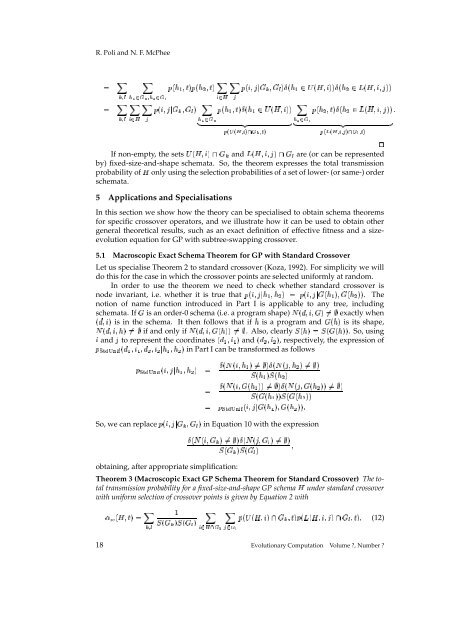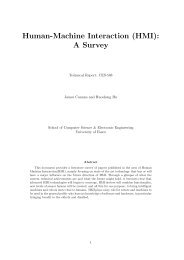General Schema Theory for Genetic Programming with Subtree ...
General Schema Theory for Genetic Programming with Subtree ...
General Schema Theory for Genetic Programming with Subtree ...
Create successful ePaper yourself
Turn your PDF publications into a flip-book with our unique Google optimized e-Paper software.
R. Poli and N. F. McPhee<br />
��� � � � ���<br />
���<br />
� � ���<br />
��� � �<br />
��� � ���<br />
�����<br />
�<br />
��� � ¥ ��§���� �<br />
¥�� � §�©���� ¥�� � §�©�� �<br />
�����<br />
�<br />
� �<br />
§ �<br />
��� � ¥ ��§���� �<br />
�������<br />
�<br />
� �<br />
�<br />
�<br />
��¥ £�§���§������ �<br />
and<br />
�<br />
§ �<br />
�<br />
� ¥�� � ����¥ £¨§������ � ¥�� � ����¥ £�§���§������<br />
�<br />
�<br />
���<br />
� � � � £¨§������ � ���<br />
� ¥�� ¥�� � §�©�� ¥�� � ����¥<br />
���<br />
§�©�� ���<br />
�<br />
� ¥�� � ����¥ £¨§���§������ �<br />
�<br />
��� � � �� ��� � ���<br />
� ��� � ��� � � ��� �<br />
If non-empty, the sets ��¥ �<br />
�<br />
are (or can be represented<br />
£¨§������<br />
by) fixed-size-and-shape schemata. So, the theorem expresses the total transmission<br />
probability £ of only using the selection probabilities of a set of lower- (or same-) order<br />
schemata.<br />
5 Applications and Specialisations<br />
In this section we show how the theory can be specialised to obtain schema theorems<br />
<strong>for</strong> specific crossover operators, and we illustrate how it can be used to obtain other<br />
general theoretical results, such as an exact definition of effective fitness and a sizeevolution<br />
equation <strong>for</strong> GP <strong>with</strong> subtree-swapping crossover.<br />
5.1 Macroscopic Exact <strong>Schema</strong> Theorem <strong>for</strong> GP <strong>with</strong> Standard Crossover<br />
Let us specialise Theorem 2 to standard crossover (Koza, 1992). For simplicity we will<br />
do this <strong>for</strong> the case in which the crossover points are selected uni<strong>for</strong>mly at random.<br />
In order to use the theorem we need to check whether standard crossover is<br />
node invariant, i.e. whether it is true � ¥ ��§���� ��� § ��� ����� ¥ ��§���� ��¥���� ��§ ��¥���� ��� that . The<br />
notion of name function introduced in Part I is applicable to any tree, including<br />
schemata. If � is an order-0 schema (i.e. a program � ¥�� §���§ � ��� ��� shape) exactly when<br />
§���� is in the schema. It then follows that if ¥�� � is a program and ��¥�� is its shape, �<br />
¥�� §���§ � ��� ��� if and only if � ¥�� §���§ ��¥�� ����� ��� . Also, clearly � ¥�� ����� ¥���¥�� ��� . So, using<br />
�<br />
and � to represent the coordinates � ¥���� � � and §�� ¥���� � � , respectively, the expression of<br />
§��<br />
� ¥���� §�� � § ��� §�� � � ��� § ��� � in Part I can be trans<strong>for</strong>med as follows<br />
�������������<br />
� ����������� � ¥ ��§���� � � § � � ���<br />
So, we can replace � ¥ ��§���� �<br />
�<br />
§ �<br />
�<br />
¥ � ¥ ��§ ��� ��� ����� � ¥ � ¥ ��§ ��� ��� �����<br />
�<br />
¥���� ��� ¥���� � �<br />
� ¥���¥�� � ����� ¥���¥�� � ���<br />
�<br />
������������� � ¥ ��§���� ��¥���� ��§ ��¥���� �����<br />
�<br />
�<br />
�������<br />
¥ � ¥ ��§ ��¥���� ����� ����� � ¥ � ¥ ��§ ��¥���� ����� �����<br />
�<br />
� in Equation 10 <strong>with</strong> the expression<br />
� ¥ � ¥ ��§ �<br />
obtaining, after appropriate simplification:<br />
�<br />
����� � ¥ � ¥ ��§ � ���<br />
¥��<br />
�<br />
��� ¥��<br />
�<br />
� �<br />
�<br />
����� ���<br />
Theorem 3 (Macroscopic Exact GP <strong>Schema</strong> Theorem <strong>for</strong> Standard Crossover) The total<br />
transmission probability <strong>for</strong> a fixed-size-and-shape GP schema £ under standard crossover<br />
<strong>with</strong> uni<strong>for</strong>m selection of crossover points is given by Equation 2 <strong>with</strong><br />
� xo ¥ £¨§�©�������� � �<br />
� ¥��<br />
� �<br />
¥��<br />
�<br />
� ���<br />
�����<br />
�<br />
�<br />
� �<br />
�<br />
��� �<br />
� ¥���¥ £¨§������ � �<br />
�<br />
§<br />
§�©���� ¥���¥ £¨§���§������ �<br />
�<br />
�<br />
� �<br />
§�©���� (12)<br />
18 Evolutionary Computation Volume ?, Number ?<br />
�




